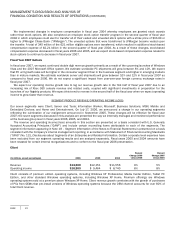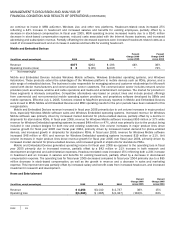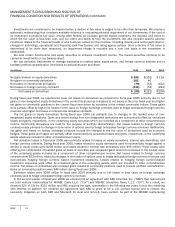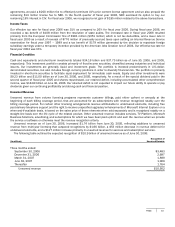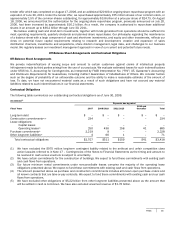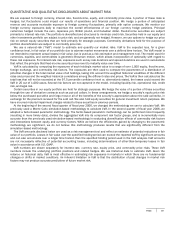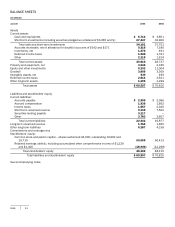Microsoft 2006 Annual Report Download - page 33
Download and view the complete annual report
Please find page 33 of the 2006 Microsoft annual report below. You can navigate through the pages in the report by either clicking on the pages listed below, or by using the keyword search tool below to find specific information within the annual report.
PAGE 32
MANAGEMENT’S DISCUSSION AND ANALYSIS OF
FINANCIAL CONDITION AND RESULTS OF OPERATIONS (CONTINUED)
Investments are considered to be impaired when a decline in fair value is judged to be other than temporary. We employ a
systematic methodology that considers available evidence in evaluating potential impairment of our investments. If the cost of
an investment exceeds its fair value, among other factors, we evaluate general market conditions, the duration and extent to
which the fair value is less than cost, and our intent and ability to hold the investment. We also consider specific adverse
conditions related to the financial health of and business outlook for the investee, including industry and sector performance,
changes in technology, operational and financing cash flow factors, and rating agency actions. Once a decline in fair value is
determined to be other than temporary, an impairment charge is recorded and a new cost basis in the investment is
established.
We lend certain fixed-income and equity securities to enhance investment income. The loaned securities continue to be
carried as investments on our balance sheet.
We use derivative instruments to manage exposures to interest rates, equity prices, and foreign currency markets and to
facilitate portfolio diversification. Net losses on derivatives were as follows:
(In millions)
2006
2005
2004
Net gain/(losses) on equity derivatives $
192
$(202)
$ 118
Net gains on commodity derivatives 10
1
46
–
Net losses on interest rate derivatives (79)
(53)
(102)
Net losses on foreign currency contracts (313)
(53)
(284)
Net losses on derivatives $
(99) $(262)
$(268)
During fiscal year 2006, we experienced lower net losses on derivatives as compared to fiscal year 2005 primarily due to net
gains on non-designated equity derivatives in the current fiscal year as compared to net losses in the prior fiscal year and higher
net gains on commodity positions in the current fiscal year driven by increases in the related commodity indices. These gains
were partially offset by higher net losses in time value on foreign exchange contracts used to hedge anticipated foreign currency
revenues and higher net losses on interest rate derivative contracts.
The net gains on equity derivatives during fiscal year 2006 are primarily due to changes in the market value of non-
designated equity derivatives. Gains and losses arising from non-designated derivatives are economically offset by unrealized
losses and gains, respectively, in the underlying equity securities which are recorded as a component of other comprehensive
income. Commodity derivatives are held for the purpose of portfolio diversification. Net losses related to foreign currency
contracts relate primarily to changes in time value of options used to hedge anticipated foreign currency revenues. Additionally,
net gains and losses on foreign exchange contracts include the changes in the fair value of derivatives used as economic
hedges. These gains and losses are partially offset economically by unrealized losses and gains, respectively, in the underlying
assets which are included in other comprehensive income.
Net derivative losses in fiscal year 2005 were primarily related to losses on equity derivatives, interest rate derivatives, and
foreign currency contracts. During fiscal year 2005, losses related to equity derivatives used to economically hedge against a
decline in equity prices were $202 million and losses related to interest rate derivatives were $53 million. These losses were
offset by the combination of realized gains on sales of securities and unrealized gains related to increases in the market value
of the underlying assets included as a component of other comprehensive income. Net losses related to foreign currency
contracts were $53 million, related to changes in time value of options used to hedge anticipated foreign currency revenues and
economically hedging foreign currency based investment exposures. Losses related to hedging foreign currency-based
investment exposures were offset by unrealized gains in the underlying assets which are included in other comprehensive
income. Net losses on derivatives also included gains related to commodity positions used to provide portfolio diversification.
Gains on commodity positions were $46 million during fiscal year 2005.
Derivative losses were $268 million in fiscal year 2004 primarily due to net losses in time value on foreign exchange
contracts used to hedge anticipated foreign currency revenues.
In the second quarter of fiscal year 2006, we entered into an agreement with NBC Universal, Inc. (“NBC”) that restructured
our joint venture relationships for MSNBC Cable L.L.C. (“CJV”) and MSNBC Interactive News, L.L.C. (“IJV”). As a result, we
divested 32% of CJV for $331 million and NBC acquired the right, exercisable in the following two years, to buy the remaining
18% interest. In addition, we modified our agreement with NBC to grant to IJV a U.S. content license and to remove the
exclusivity obligation on both NBC and Microsoft for local and non-U.S. news content. As part of the MSNBC restructuring


